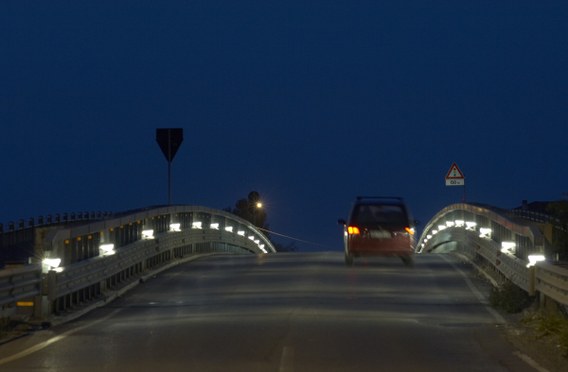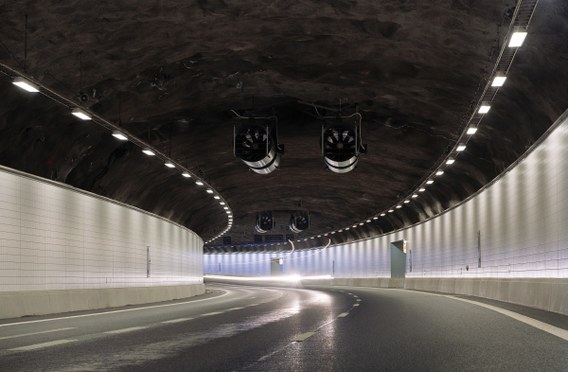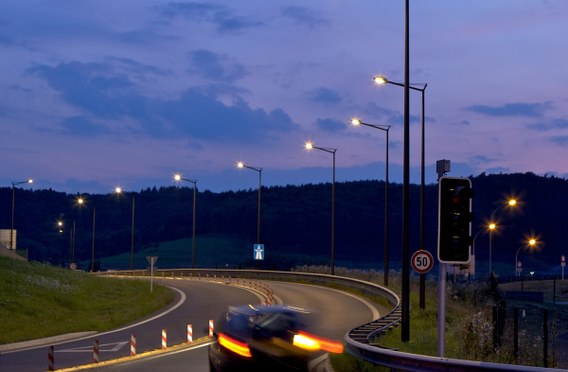Road and Tunnel
Creating the right environment
When lighting traffic routes the primary concern is safety and comfort, especially in conflict areas where traffic may be merging, becoming compressed or changing direction or in stretches of open road where traffic speeds may be high.
To ensure safety on stretches of open road involves visibility over relatively large distances, generally 30 metres or more, to account for the high traffic speeds that may be present. To achieve this at below optimal lighting levels for our eye requires a different approach to lighting which is to light the road surface, making objects appear in silhouette against the bright surface. However where speeds can be expected to be lower and objects closer, such as in conflict areas or tunnels, this no longer works as the road surface may be visually below the object outline preventing it appearing as a silhouette, and therefore the objects themselves need to be lit as opposed to the road surface. These changing requirements are reflected in the design criteria, luminance for traffic routes and illuminance for conflict areas and tunnels.
In Europe lighting requirements for roads are given in the document EN 13201 Road Lighting. This document is in multiple parts and describes how to decide the relevant road class and then the lighting requirements that this class requires. Lighting requirements for tunnel lighting are given in document CR 14380 Lighting Applications – Tunnel Lighting. However this document is a report not a standard and should be used in conjunction with local practice.
Best practice
The luminaires should be appropriate for the local climactic conditions. For open areas the fitting should ideally be shaped and mounted to minimise windage, which is the effect of wind producing a stress on the luminaire and all mounting equipment. All brackets, columns, etc. should be rated to withstand the maximum windage that will be encountered. In enclosed spaces such as tunnels the luminaire should be capable of withstanding mechanical shock caused by possibly near-continuous vibration as well as the poor air-quality which may contain corrosive pollutants.
Positioning of luminaires should provide maximum guidance as to the geometry of the road, giving a coherent visual story to a road user. It should be ensured that some light spills behind the edges of the road to allow visibility of objects off the carriageway that may pose a hazard, however this should be controlled to prevent excessive obtrusive light.
For tunnels the lighting should provide a smooth transition between the entrance, tunnel interior and exit zones allow the eye to adjust to the different ambient light levels. All tunnel surfaces should be lit to ensure a comfortable and safe passage through the space.
For both roads and tunnels care should be taken to prevent distracting flicker caused by bright sources of light travelling in a periodic way through the field of view (the car windscreen). This can give a similar effect to a stationary light dimming and increasing in response to the electrical supply.
Taking control
The use of photocell switching to react to levels of daylight or timed on/off can ensure the correct light at the required time. Dimming of lighting at hours of low usage, such as the use of bi-power dimming which reduces the lighting during the early hours of the day, can significantly reduce energy usage. In addition a more advanced lighting control system can allow the lighting levels to be set to the requirements of a situation, such as raising the lighting levels at the scene of an accident or traffic congestion whilst allowing central monitoring of lighting to ensure peak light management with optimal maintenance.
High efficiency control gear that minimise electrical losses, especially for higher power lamps, help increase energy efficiency, whilst the use of a high quality optic to control the light helps reduce waste light that falls outside the target area.
Key Products
Road Lighting
- R2L2
- CiviTEQ
Tunnel Lighting
- GTLED
- Applications in Focus Road Lighting
(PDF/
3 MB)
Download Thorn's Application in Focus: Road Lighting brochure, which provides further information on the various areas of Road Lighting.



